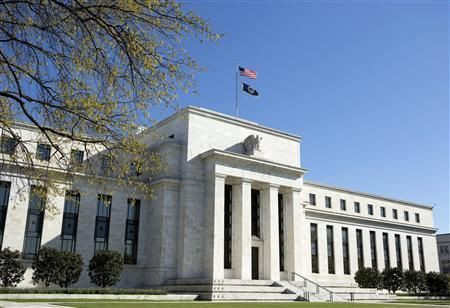FOMC Minutes: Fed Sees October End To Asset Purchases

(Reuters) - The Federal Reserve has begun detailing how it plans to ease the U.S. economy out of an era of loose monetary policy, indicating it will end its asset purchases in October. It also signalled that it's near agreement on a plan to manage interest rates in the future, according to the minutes of the last Fed policy meeting.
The minutes, from the June 17-18 Federal Open Market Committe meeting, indicate the Fed envisions using overnight repurchase agreements in tandem with the interest it pays banks on excess reserves to set a ceiling and floor for its target interest rate.
Though no decisions have been announced, the discussion has become detailed enough for Fed officials to define the proper spread between the two -- which was mentioned in the minutes as 20 basis points.
The minutes revealed that the Fed participants "generally agreed" that its monthly bond purchases would end in October, with a final reduction of $15 billion in the amount of U.S. Treasuries and mortgage-backed securities it buys each month.
The alternative would have been to leave $5 billion a month in purchases intact until December, but "most participants viewed this as a technical issue with no substantive macroeconomic consequences."
There also was more detailed discussion than previously about the central bank's current policy of reinvesting its $4.2 trillion in asset holdings as the securities mature.
Policymakers have debated how to reduce those holdings without disrupting financial markets. They are divided over whether reinvestment should stop before or after an initial decision to raise interest rates.
In addition, there was discussion about how the reinvestment decision may not be an all-or-nothing choice, with the central bank possibly letting some maturities expire each month and reinvesting the proceeds of others in an effort to "smooth the decline in the balance sheet," according to the minutes.
The Fed’s exit strategy is complicated by its massive stimulus programs, which have flooded financial markets with cash and stifled daily participation in the Fed funds market that's traditionally used to manage interest rates.
The new reverse repo facility and the interest on overnight reserves are meant to give the Fed new tools to influence rates once policymakers agree they should start to rise again.
The new reverse repo facility, which remains in test phase but is expected to be formally adopted, is designed to control cash held by the money market funds and mortgage agencies that can’t deposit money with the Fed, not just banks.
Raising or lowering the interest on excess reserves can encourage or discourage banks from holding money at the Fed.
(Reporting by Howard Schneider; Editing by Paul Simao)
© Copyright IBTimes 2024. All rights reserved.
Join the Discussion





















